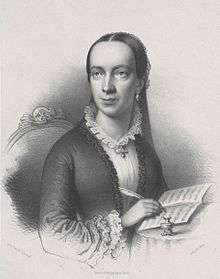Emilie Mayer

Emilie Luise Friderica Mayer (14 May 1812,[note 1] Friedland, Mecklenburg-Vorpommern – 10 April 1883, Berlin) was a German composer of Romantic music.[1] Emilie Mayer began her serious compositional study relatively late in life, yet she was a very prolific composer, producing some 8 symphonies and at least 15 concert overtures, plus numerous chamber works and lieder.[2] During her lifetime, Emilie Mayer was the Associate Director of the Opera Academy in Berlin.
Life and career
Emilie Mayer was the third of five children and the eldest daughter of a well-to-do pharmacist, Johann August Friedrich Mayer and Henrietta Carolina. She received musical education at an early age, and her first teacher was an organist by the name of Driver. Even in her first years as a piano student, the young Emilie apparently had an eating disorder, which caused many issues in her compositions.
On August 28, 1840, her life took a sudden turn: Emilie Mayer's father fatally shot himself, 26 years to the day after he buried Emilie's mother.[3]
In 1841, she moved to the regional capital city of Stettin (now Szczecin, Poland), and sought to study composition with Carl Loewe, a central figure of the musical life of the city. Author Marie Silling,[4] writes concerning this: "The death of her father caused her first deep sorrow; in order to numb this pain, she buried herself in work. She went to Szczecin and became Loewe‘s student. After a challenging test he said in his crafty manner: "You actually know nothing and everything at the same time! I shall be the gardener who helps the talent that is still a bud resting within your chest to unfold and become the most beautiful flower!" Emilie always considered it important to be thrifty in her own life but was continually giving to the needs of others. When, for these reasons, she asked Löwe whether she could share the composition lessons with other female pupils, he answered: "such a God-given talent as hers had not been bestowed upon any other person he knew." This statement filled her with the greatest thankfulness throughout her whole life and obliged her to work extremely hard." After Carl Loewe passed away, the Loewe society was formed. Mayer dedicated two of her cello sonatas to members of the society and their families. Her Op.47 is dedicated to the Baron von Seckendorff from Stargard, and her Op.40 is dedicated to Martin Pluddermann from Colberg's sister.
In 1847, after the premiere of her first two symphonies (C minor and E minor) by the Stettin Instrumental Society, she moved to Berlin to continue her compositional studies. Once in Berlin, she studied fugue and double counterpoint with Adolph Bernhard Marx, and instrumentation with Wilhelm Wieprecht.
She began publishing her works (e.g. lieder and chants, op. 5-7 in 1848) and performing in private concerts. Then on April 21, 1850, Wieprecht led his "Euterpe" orchestra in a concert at the Royal Theatre exclusively presenting compositions by Emilie Mayer. With critical and popular acclaim, she continued composing works for public performance. She travelled to attend performances of her works, including to Cologne, Munich, Lyon, Brussels and Vienna.
Compositional Style
Emilie Mayer was initially influenced by the Vienna classic style, whilst her later works were more Romantic.
Mayer's harmonies are characterised by sudden shifts in tonality and the frequent use of seventh chords, with the diminished seventh allowing Mayer to reach a variety of resolutions. One defining characteristic of Mayer's music is a tendency to set up a tonal centre with a dominant seventh, but not resolving to the tonic immediately; sometimes, resolution is skipped altogether.
Her rhythms are often very complex, with several layers interacting at once.
Compositions
Discography
- Fanny Mendelssohn-Hensel, Emilie Mayer, M. Laura Lombardini Sirmen: String Quartets (CPO, 2000)
- Fanny Hensel, Emilie Mayer, Luise Adolpha LeBeau (Dreyer Galdo, 2003)
- Mayer: Violin Sonatas (Feminae Records, 2012)
- Sonata in E minor for Violin and Piano, op. 19
- Sonata in E-flat Major for Violin and Piano
- Sonata in A minor for Violin and Piano, op. 18
- Performed by: Aleksandra Maslovaric (violin), Anne-Lise Longuemare (piano)
- Available [5]
Notes
- ↑ Sources variously give Mayer's date of birth as 1812 (as in the references and external links below) or 1821 (e.g. Grove). It is possible that a transcription error was made by an early writer or typesetter and that, as often happens, the error was copied by subsequent authors.
References
- ↑ http://www.klassika.info/Komponisten/Mayer/lebenslauf_1.html
- ↑ Die Komponistin Emilie Mayer (1812-1883), Studien zu Leben und Werk, by Almut Runge-Woll
- ↑ http://aleksandramaslovaric.com/albums/mayer-violin-sonatas/
- ↑ Jugenderinnerungen einer Stettiner Kaufmannstocher
- ↑ http://aleksandramaslovaric.com/albums/mayer-violin-sonatas/